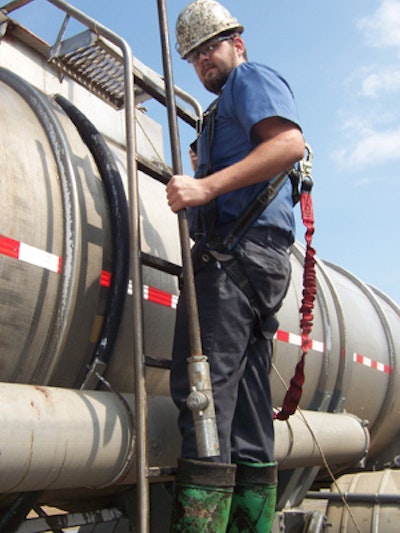
Interested in Waterblasting?
Get Waterblasting articles, news and videos right in your inbox! Sign up now.
Waterblasting + Get AlertsWhen Tina Brown talks about her employees at Bastrop Tank Wash Inc. taking a tanker trailer for a “spin,” she’s not referring to a trip around the block. In her world, “spin” means a thorough, high-pressure cleaning – courtesy of a powerful rotating-nozzle system manufactured by Gamajet Cleaning Systems Inc.
Brown purchased three Gamajet machines when she started her business in Bastrop, La., in 2007. The company uses two Gamajet V water-driven nozzles for cleaning and a Gamajet V nozzle, along with a cart-mounted Gamajet VIII, for applying a “pre-solve” (or pre-treatment) liquid chemical for tougher cleaning jobs.
The company, which cleans giant chemical trailer tankers, test-drove the Gamajets by renting them for three or four months before purchasing them. They all proved equal to the task of removing difficult-to-clean chemicals from the inside of tankers, mostly with 7,000-gallon capacities.
“We want to get trucks in and out as fast as possible,” Brown says. “On an average day, we clean anywhere from 14 to 30 tanks a day. The ‘spinners’ perform the bulk of our workload, so they are really important to our operation’s productivity and profitability. It’s far more efficient to let a machine do the majority of the work.”
The tanks carry everything from what Brown calls “lighter” chemicals, such as petroleum distillates, which don’t cling to the tanker walls, to heavier, stickier materials that she says are comparable to model-airplane glue.
“We can clean the lighter materials in a total of about 30 minutes, while the really bad stuff can take days,” she notes. “Sometimes we have to pre-solve a tank and let it sit overnight before we can clean it.”
The Gamajet machines employ two nozzles that gyrate around and up and down to spray hot water mixed with strong cleaning chemicals in a 360-degree pattern. Crews typically hook up the cleaning nozzles to a pressurized hot-water system, which helps the nozzles generate pressure of 400 psi at 21 gpm. A boiler heats water up to 220 degrees F, she says.
The Gamajet is attached to a rigid pipe that’s hooked up to a water hose. Crews use the pipe to lower the cleaning nozzles down into the tank through either a manhole (typically 24 inches in diameter) or washout holes (usually three to four inches in diameter).
Next, computerized operation allows crew members to punch in specific information about things such as the kind of chemical cleaner needed, the kind of wash required, the timing of wash and rinse cycles and so forth. A plastic shield that covers the manhole or washout holes prevents the nozzles from falling to the bottom of the tank, and also prevents water and chemicals from spurting up and out of the tank, she explains.
Brown also lauds the Gamajet because it improves safety by reducing the number of times employees must go inside the tanks. In fact, she specifically bought the pre-solve “spinner,” which can be water- or air-driven, to reduce employee in-tank exposure to the stronger chemicals and heavier fluids used by that system.
“Anytime you can minimize the time someone has to spend inside a tank, it’s better,” she notes. “At some point, someone always has to go inside the tank and make sure it’s clean. But the Gamajet greatly reduces the need for confined-space work.”
Wastewater that drains from the tanks passes through a treatment filter before being stored in a 20,000-gallon, aboveground storage tank. There it’s treated chemically until it’s safe to drain it into a city sewer line for treatment at a wastewater facility, she says.
Brown says the Gamajets her company owns provide her with the best marketing program available: word-of-mouth referrals.
“The Gamajets definitely help us obtain new business,” she says. “They ensure that we provide quality service for our customers. If we provide quality service for customers, those over-the-road drivers talk a lot to other drivers, and tell them about our service. Then those drivers, in turn, tell their dispatchers about us.
“We probably have 150 different trucking companies on our books right now,” she adds. “I don’t even do any advertising, so I know that word-of-mouth referrals are most likely generating any new business.”
Which means more trucks available for employees to take out for a “spin.”







